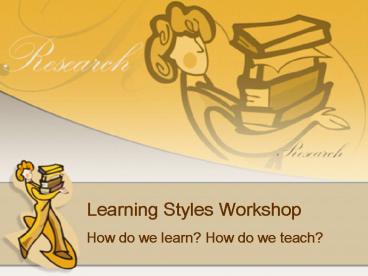Learning Styles Workshop - PowerPoint PPT Presentation
1 / 25
Title:
Learning Styles Workshop
Description:
College & Research Libraries, 51(2), 113-119. Kolb's Four Phases of the Learning Cycle (pg. ... Metaphors and images. Comparisons and contrast. Avoid ... – PowerPoint PPT presentation
Number of Views:121
Avg rating:3.0/5.0
Title: Learning Styles Workshop
1
Learning Styles Workshop
- How do we learn? How do we teach?
2
Attendees Will
- Determine their learning style, in order to
brainstorm teaching techniques and activities
preferred by the 4 learning styles. - Construct instruction plans that teach to the
different learning styles, in order to recognize
how learning style preferences can be addressed
in training and instruction.
3
What Impacts Our Teaching Style?
- Our Own Learning Style
- How We Were Taught
- Instructional Content
- Size of Class
4
Student Learning Styles
- Students enter learning situations with
established learning styles. Most teaching
methods, however, appeal only to a certain
learning style and handicap those who would
prefer to learn in another way. - Bodi, Sonia. (1990). Teaching effectiveness and
bibliographic instruction The relevance of
learning styles. College Research Libraries,
51(2), 113-119.
5
Kolbs Four Phases of the Learning Cycle (pg. 4)
- Concrete Experience (CE)
- Learning by experience
- Learning from specific experiences
- Relating to people
- Being sensitive to feelings and people
6
Kolbs Four Phases of the Learning Cycle (pg. 4)
- Abstract Conceptualization (AC)
- Learning by thinking
- Logically analyzing ideas
- Planning systematically
- Acting on an intellectual understanding of a
situation
7
Kolbs Four Phases of the Learning Cycle (pg. 4)
- Active Experimentation (AE)
- Learning by doing
- Showing ability to get things done
- Taking risks
- Influencing people and events through action
8
Kolbs Four Phases of the Learning Cycle (pg. 4)
- Reflective Observation (RO)
- Learning by reflecting
- Carefully observing before making judgments
- Viewing issues from different perspectives
- Looking for the meaning of things
9
Kolb Learning Style Inventory
- Rank the endings for each sentence according to
how well you think each ending describes the way
you learn (4 best represents how you learn 1
least represents how you learn) - Flip to the second page of the answer form and
add up the number of points for each shape
10
Kolb Learning Style Inventory
- Take your scores for the four learning modes and
subtract as indicated to get your two combination
scores (pg. 6) - Plot your 2 combination scores on the Learning
Style Type Grid (pg. 7) - This will indicate your preferred learning style
11
Kolbs Basic Learning Style Types
- Accommodating Strengths
- Getting things done
- Leading
- Taking risks
- Initiating
- Being adaptable and practical
12
Kolbs Basic Learning Style Types
- Diverging Strengths
- Being imaginative
- Understanding people
- Recognizing problems
- Brainstorming
- Being open-minded
13
Kolbs Basic Learning Style Types
- Converging Strengths
- Solving problems
- Making decisions
- Reasoning deductively
- Defining problems
- Being logical
14
Kolbs Basic Learning Style Types
- Assimilating Strengths
- Planning
- Creating models
- Defining problems
- Developing theories
- Being patient
15
Learning Styles Exercise
- Break into groups based on your learning style
- Brainstorm and jot down teaching techniques which
help you learn - Report to the other groups
16
Kolbs Basic Learning Style Types
- Accommodators Learning Preferences
- Accommodators may prefer to work with others to
get assignments done, to set goals, to do field
work, and to test their different approaches to
completing a project.
17
Kolbs Basic Learning Style Types
- Teaching to Accommodators
- Combining Doing Feeling
- Verbal processing, talking, discussion
- Cooperative learning methods
- Role playing, personification techniques, games
- Lectures combined with questioning and discussion
- Real-life situations
- Sequential presentations (basics to concepts)
- Presentations that break tasks into several small
steps - ACRL Institute for Information Literacy 2005
18
Kolbs Basic Learning Style Types
- Divergers Learning Preferences
- Divergers may prefer working in small groups to
gather information, listening with an open mind,
and receiving personalized feedback.
19
Kolbs Basic Learning Style Types
- Teaching to Divergers
- Combining Feeling, Watching Listening
- Use adjectives and sensory words
- Metaphors and images
- Comparisons and contrast
- Avoid memorization and logic
- ACRL Institute for Information Literacy 2005
20
Kolbs Basic Learning Style Types
- Convergers Learning Preferences
- Convergers may prefer to experiment with new
ideas, simulations, laboratory assignments, and
practical applications.
21
Kolbs Basic Learning Style Types
- Teaching to Convergers
- Combining Thinking Doing
- Sequential presentation of materials
- Presentations that begin with small pieces of the
task - Tactile elements that demonstrate principles
- Demonstrations of problem-solving skills
- Skill and drill repetition
- Opportunities to work alone
- ACRL Institute for Information Literacy 2005
22
Kolbs Basic Learning Style Types
- Assimilators Learning Preferences
- Assimilators may prefer lectures, readings,
exploring analytical models, and having time to
think things through.
23
Kolbs Basic Learning Style Types
- Teaching to Assimilators
- Combining Thinking, Watching Listening
- Present the overall concept first
- Processing time alone to master material
- Avoid repetitious exercises
- Compare and contrast
- Avoid memorization, highlight patterns in
information to facilitate recall, use mnemonics - ACRL Institute for Information Literacy 2005
24
Learning Styles Exercise
- Scenario
- You have been tasked with training your
colleagues to use a new database or software
program. - Plan to teach a class to the group opposite your
learning style. Based on what the group just
reported, what teaching techniques will you use? - Report to other groups
25
Learning Styles Exercise
- Scenario
- You have been tasked with training your
colleagues to use a new database or software
program. - How could we address all four learning styles?































